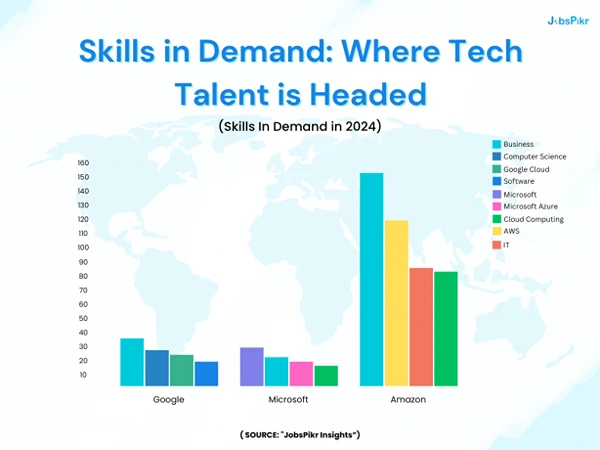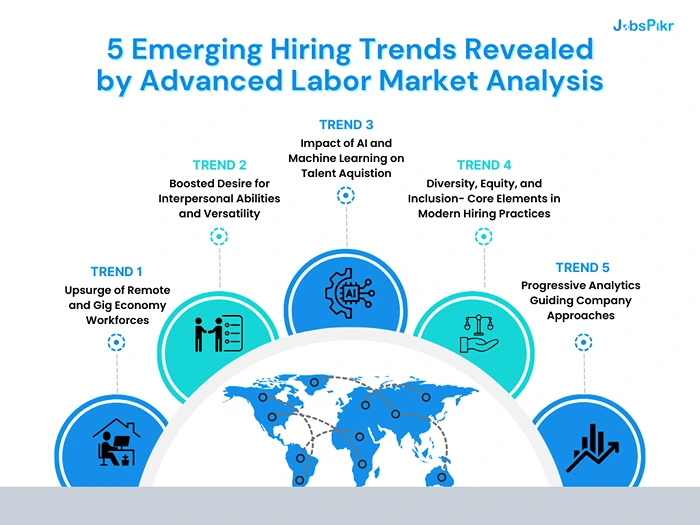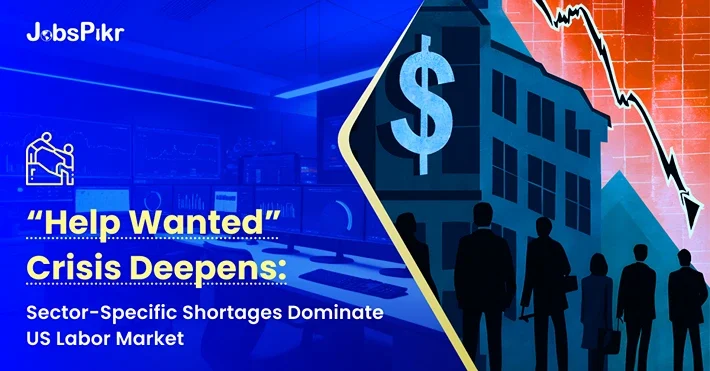- The US Labor Market Crisis
- Why Generic Hiring Strategies Keep Crashing and Burning
- The Pivot: Hyper-Specific Job Data Is the Difference Maker
- The Engine Powering This: Job Scraping Tools
- From Panic to Plan: How Smart Employers Are Winning
- The Need for Job Data to Understand the US Labor Market
- Frequently Asked Questions
Okay, let’s talk about those “Help Wanted” signs. You see them everywhere now, right? Feels like we blinked and suddenly every storefront, every online ad, is screaming for workers. What we’re really in is a mess of sector-specific shortages. To make any sense of this tangled US labor market, you need sharper tools.
What businesses desperately need is real-time, specific job data and legit labor market analytics.
The US Labor Market Crisis
Sure, the big-picture numbers still show tons of jobs open. Last I checked the JOLTS report (that’s the Job Openings and Labor Turnover Survey, for those unfamiliar), the U.S. was still sitting on over 9 million unfilled positions. Unemployment remains low. On paper? We’re in a classic tight labor market.

Image Source: Indeed Hiring Lab
Healthcare: A Deepening Crisis with No Easy Cure
Let’s start with healthcare – an industry that’s quietly teetering on a staffing cliff. Nurses, medical techs, home health aides – the talent vacuum here is vast and growing.
There’s a good reason for that. The combination of an aging population, post-pandemic burnout, and increased demand for services has created a massive, sustained pressure on the healthcare talent pipeline.
The Bureau of Labor Statistics (BLS) projects healthcare occupations will grow significantly faster than average, with around 1.8 million openings annually from 2022 to 2032, due to both expansion and replacement needs.

Image Source: JobsPIkr Workforce Trends in Healthcare
These roles aren’t easy to fill quickly. Licenses, certifications, and years of training – they all act as bottlenecks in the hiring process. The result? Healthcare employers are constantly playing catch-up. This sector isn’t just understaffed; it’s structurally talent-starved.
Hospitality & Leisure: The Turnover Treadmill
Next, take a stroll into a busy restaurant on a weekend. Odds are, you’ll spot visibly overwhelmed staff trying to juggle too many tables, ringing up orders, and training new hires — all at once. Hotels and restaurants aren’t just hiring constantly; many are stuck in perpetual churn mode.
Post-pandemic US labor market recovery brought back demand fast, but the industry has struggled to keep up on the talent side. The jobs are tough – low margins, high stress, physically demanding – and turnover remains sky-high. Owners I’ve spoken to describe the same exhausting cycle: hire, train, lose, repeat.
It’s not just frustrating; it’s expensive. Constant rehiring drains resources, tanks productivity, and erodes customer experience. The sector feels like it’s sprinting just to stand still.
Skilled Trades: The Quiet Exodus
Electricians. Plumbers. Welders. HVAC specialists. These are the people who keep the physical world functioning – and they’re becoming harder and harder to find.
Why? Two big reasons: a wave of retirements from older skilled workers, and not enough young people replacing them. For many years, vocational paths were downplayed in favor of college degrees. That cultural shift has left a gaping hole in the trades pipeline.
And this isn’t just a temporary blip. It’s a long-term structural gap. Apprenticeship programs can’t scale fast enough to meet demand. In some regions, it’s now near-impossible to book a service call without a multi-week wait.
What’s emerging is a classic supply-demand mismatch. These roles are becoming golden — but only for those already trained.
Technology: Layoffs and Unicorns
Yes, we’ve all seen the headlines about big tech layoffs in the US labor market. And yes, some roles — especially in generalist functions — have cooled off.
Demand for specialized tech talent — AI/ML experts, cybersecurity professionals, cloud architects — remains incredibly strong. These roles are vital across industries, from finance to healthcare to logistics. Finding someone with just the right combination of skills? Often feels like chasing a unicorn.

Image Source: Economic Indicators for the Tech Workforce by JobsPikr
It’s a tale of divergence: while some job families get flooded with applicants, others are starved for qualified candidates. And in many cases, hiring managers are still struggling to fill those high-skill seats.
The kicker? Many organizations are still using generic recruitment strategies, which aren’t equipped to surface rare tech talent in an increasingly fragmented ecosystem.
Education: A Silent Shortage
Finally, let’s talk education. The demand for teachers has skyrocketed in recent years as the number of professionals taking up these roles has seen staggering declines. One of the reasons is that it’s a notoriously underpaid profession demanding a lot of effort.
It’s especially acute in high-demand areas like STEM, special education, and bilingual instruction. And it’s not just a temporary post-COVID hangover. It’s a broader systemic issue.
Teacher training programs are shrinking. Burnout is real. Compensation hasn’t kept up with inflation, especially in expensive urban markets. Schools face increasing behavioral and administrative burdens, while support systems shrink.
The result? A quiet but growing shortage that’s reshaping the future of education. Since it’s not “breaking news,” it doesn’t get the attention it requires, and the situation goes unnoticed.
The Bigger Picture: Where’s the Problem in the US Labor Market?
The US labor market is fractured, like most economies. Some sectors are oversupplied. Others are in freefall. Some jobs attract hundreds of applicants. Others can’t get a qualified resume in a month.
There isn’t a one-size-fits-all solution here, and businesses need to adapt quickly to reverse any damage.
Why Generic Hiring Strategies Keep Crashing and Burning
When employers apply broad, unfocused hiring tactics to deeply specific labor issues, the result is almost always the same: confusion, waste, and missed opportunities.
Let’s break down where most generic strategies go wrong:
The “Spray and Pray” Trap
Blasting job ads across every platform feels like action. But the return? Usually, a mountain of unqualified applications and wasted recruiter hours. Meanwhile, the perfect candidate — the one with the right credentials, in your region, actively looking — never even sees the ad.
It’s not just inefficient. It’s demoralizing for hiring teams. Without targeted placement and messaging, you’re shouting into the void.
Flying Blind on Compensation
Relying on outdated salary surveys or “industry averages” is risky, especially when the market moves quickly. That “competitive” offer may actually be 15% below what nearby employers are already paying. Guess what happens then? Your top candidate vanishes. Or worse, takes your offer, then jumps ship a month later when a better one comes along.
Granular, real-time pay data is no longer optional. It’s needed to ensure the right talent is hired and stays long-term. Salary benchmarking has to be a regular, recurring process.
Upskilling That Misses the Mark
Training your current team is smart — but only when it addresses actual skill gaps. Too often, companies invest in broad, unfocused upskilling initiatives (“leadership development,” “Excel bootcamps”) that sound great but do little to move the needle on operational needs.
If you don’t know which skills are in demand in your sector and your market, your training investment is likely to fall flat.
Planning with a Foggy Lens
Forecasting hiring needs based on national job growth stats? That’s like checking the national weather map to decide if you need a raincoat today. You need visibility at the local, industry, and job-function level to make real workforce decisions.
Without that granularity, businesses end up overhiring, under-hiring, or hiring the wrong mix of talent — all expensive mistakes.
The Pivot: Hyper-Specific Job Data Is the Difference Maker
So what’s the alternative?
Granular labor market intelligence. Real-time job data that zooms in on sector, geography, job title, and skillset — not vague macroeconomic indicators.
Think of it like upgrading from a blurry GPS to turn-by-turn directions in heavy traffic. The difference in clarity is massive.
Here’s how hyper-specific labor data empowers smarter decisions:
Find the Right Talent Where They Actually Are
Forget the big job boards as your only source. Where are skilled welders really hanging out online? Which local union boards, Facebook groups, or niche forums do they use?

Detailed labor market analytics from tools like JobsPikr help uncover these hidden talent pools — and guide your recruiting dollars to the places that actually matter.
Make Offers That Compete — Without Overpaying
Real-time compensation data at the city, role, and company-size level lets you craft offers that hit the mark. You don’t need to guess. You know what it takes to compete — and you can do it efficiently.
This prevents overpaying in cool labor markets and underbidding in hot ones — both of which cost you in the long run.
Crack the Turnover Mystery
Why are employees leaving? Is a competitor poaching them? Is cost of living pushing them out of your region? Are they shifting careers entirely?
Labor market data — especially when it tracks job ad trends, hiring velocity, and candidate movement — helps you connect the dots. Instead of reacting to exits, you can preempt them.
Predict Trouble Before It Hits
Good data doesn’t just explain today. It forecasts tomorrow.
If job postings for your key roles are spiking nationally, but training programs aren’t keeping pace? That’s your signal. You’ve got a shortage coming. Time to train internally, build external partnerships, or rethink automation.
It’s your early-warning system in a chaotic labor landscape.
The Engine Powering This: Job Scraping Tools
Where does this goldmine of job intelligence come from?
Job scraping tools. These tools constantly collect job postings from across the digital landscape — company sites, job boards, niche communities — and organize them into a unified dataset.
But the value isn’t just in collecting. It’s in:
- Standardizing job titles and formats
- Normalizing pay data
- Tagging industries, company sizes, and skill mentions
- Analyzing trends over time and space
This raw data is what fuels modern labor market analytics. Without it, we’d be stuck guessing — or relying on months-old government reports that don’t reflect what’s actually happening on the ground.
From Panic to Plan: How Smart Employers Are Winning
Once you’ve got the data, the next step is using it smartly. Here’s how leading companies are turning job data into real-world wins:
Sniper-Style Recruiting
Targeted messaging. Right platform. Right timing. When you know where your ideal candidates live online and what language they respond to, you stop wasting budget and start attracting quality applicants fast.
Competitive Pay That Adjusts in Real Time
No more annual “set it and forget it” salary reviews. Use live market data to adjust your offers as needed — quarterly, even monthly. That keeps you in the game without overextending.
Bullseye Training and Retention
Build training programs based on actual demand in your sector. Identify flight risks early. Create career paths that matter in your niche. Retain better. Upskill smarter.
Proactive Workforce Planning
Unite HR, ops, and finance using predictive hiring models. Budget for talent, not just headcount. Build pipelines before roles go unfilled. It’s not reactive — it’s strategic.
Smarter Location Decisions
Opening a new branch or facility? Know if the right talent exists there before you commit. Model costs, hiring velocity, and competition risk, and avoid costly mistakes.
The Need for Job Data to Understand the US Labor Market
The US labor market isn’t going back to “normal.” It’s permanently complex, fragmented, and fast-moving. In this reality, gut instinct, outdated surveys, and generic strategies don’t cut it.
You need sharp, localized, role-specific labor market intelligence — powered by job scraping and smart analysis — to compete.
This is how you attract talent, retain your best people, cut hiring costs, and scale with confidence.
Try JobsPikr today to see how data on skill shortages, emerging roles, talent pools, and geographic information can help you in your hiring decisions.
Frequently Asked Questions
How is the current U.S. labor market?
The U.S. labor market remains relatively stable but is showing signs of cooling off compared to the rapid post-pandemic recovery. Unemployment has stayed near historic lows, hovering around 4%, and job growth continues, though at a slower pace than in previous years. Some industries, particularly government, healthcare, and education, are still hiring steadily, while others, like technology and manufacturing, have seen reduced activity or selective hiring.
At the same time, wage growth has moderated, and fewer workers are voluntarily quitting their jobs, often seen as a signal that employees are less confident about quickly finding better opportunities.
Is the U.S. labor market weakening?
Yes, there are indicators that the labor market is gradually losing momentum. Monthly job creation has slowed, and certain sectors have seen a drop in job postings and new hires. In addition, long-term unemployment has slightly increased, and labor force participation remains below pre-pandemic levels, especially among older workers.
How is the job market in the USA?
The U.S. job market is currently mixed. While employment opportunities remain solid in many areas—especially in health care, logistics, and skilled trades—some fields are experiencing hiring freezes or slower recruitment due to economic uncertainty.
Employers have become more cautious, prioritizing efficiency over aggressive expansion. Candidates with in-demand skills still find opportunities, but the pace of hiring is more measured, and competition can be tougher in certain sectors like tech or finance.
Is there a labor shortage in the USA?
Yes, the U.S. continues to face a labor shortage in several key industries. Roles in health care, construction, trucking, hospitality, and child care remain difficult to fill. Several factors contribute to this shortage, including an aging workforce, lower immigration levels, skill mismatches, and shifting worker preferences post-pandemic.
While the overall unemployment rate is low, the supply of qualified workers isn’t always aligned with where the demand is greatest, leading to persistent hiring challenges for employers in specific fields.




